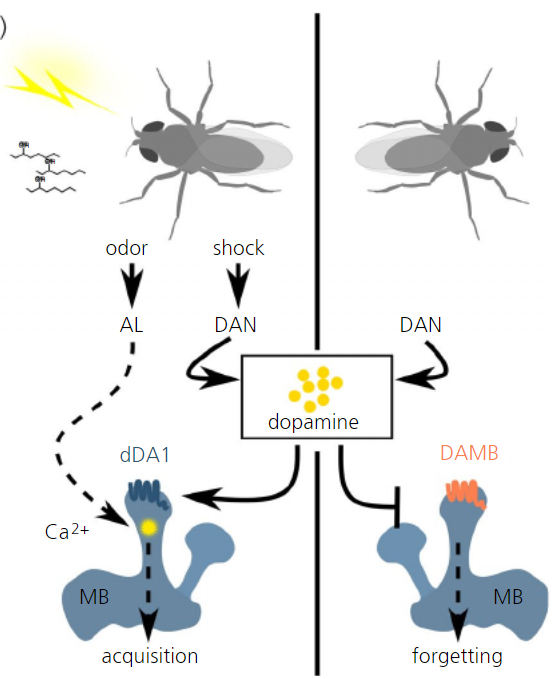Learning and Memory Research Using Drosophila
Understanding the mechanisms of memory and learning formation is a fundamental goal of neuroscience research and contributes to the understanding of the basic cognitive functions of the human brain. Based on years of experience and advanced Drosophila research platform, CD BioSciences is combining Drosophila brain research with neural circuit studies of learning and memory to facilitate the exploration of brain structures and cognitive functions. We are now introducing the application of Drosophila research to learning and memory for our global clients.
Introduction of Learning and Memory in Drosophila
Drosophila Brain Structure Controlling Learning and Memory Behavior
Despite being smaller than a grain of rice, the Drosophila brain possesses complex information processing and learning memory capabilities. It was found that the learning training of odor or visual graphics coupled with heat punishment and electric shock, successfully allows Drosophila to generate associative memory and avoid coupled graphics and odors. The well-established neural research model of learning behavior offers the possibility to deeply explore the function of different brain regions even in complex behavior. For example, the Drosophila fan-shaped body shows different functions in graphical memory and are involved in processing graphical features. As the study progressed, different neuronal structures were found having different functions in visual input memory, e.g., the R2 and R4m ring neurons of the ellipsoid body are also involved in visual graph learning and memory, but are not related to visual graph parameters.
Neuromodulation in Learning and Memory circuits
In addition to brain structures, Drosophila has conserved biochemical signaling mechanisms for learning memory. Many neuromodulators, especially monoamines and neuropeptides, which typically act by binding to G protein-coupled receptors (GPCRs), have been identified to participate in olfactory learning and memory in Drosophila. For example, Drosophila dopamine can influence the acquisition and forgetting of olfactory memory after learning via mushroom body dopamine receptors. In addition, octopamine signaling drives different types of learning behaviors in flies by acting on different brain regions, including olfactory learning of aversion and appetite.
 Fig.1 Dopaminergic signalling in Drosophila affects both acquisition and forgetting of olfactory memories (Van Damme et al. 2021)
Fig.1 Dopaminergic signalling in Drosophila affects both acquisition and forgetting of olfactory memories (Van Damme et al. 2021)Advantages of Drosophila-based Learning and Memory Research
Learning is essential for organisms, and learning and memory mechanisms are conserved throughout phylogeny. In the last decade, invertebrate models, including Drosophila, have played an important role in elucidating the molecular pathways and the mode of neuromodulation in learning circuits. The relatively compact nervous system in Drosophila have enabled the study of neuromodulation at cellular resolution.
- Drosophila, is capable of non-associative and associative learning studies, including classical and operant conditioning, as well as sensitization and habituation.
- Besides, Drosophila has a full range of short-term (immediate molecular action) and long-term (de novo transcription and synaptic plasticity) memory functions, allowing for the exploration of its ancient conserved mechanisms.
- Memory analysis in Drosophila has emerged as an important model for studying the molecular of cognitive deficits associated with ID genes. Since the clinically important phenotype of intellectual disability (ID) is impaired learning and memory ability.
By integrating molecular and functional knowledge of learning circuits from different invertebrate and vertebrate models, studies in Drosophila do certainly help to further unravel the mechanisms and evolution of learning behaviors and function.
Related Services
CD BioSciences Drosophila Center takes advantage of Drosophila's knowledge and technology platform to provide customers with professional research solutions. We support identification, validation neurons and omics analysis at the single-cell level, improving the speed and success of our clients' access to learning neural circuits. Our services go beyond this and our techniques go beyond this!
Drosophila Neural Circuits Analysis
Drosophila Model Customization
Drosophila Optogenetic Service
Our Advantages
-
Professionalism
We have built a professional Drosophila modeling platform and a team with rich neuroscience experience and cutting-edge knowledge to ensure the scientific direction of the project. -
Personalized Service
We provide one-stop scientific solutions for metabolism and diseases research to accelerate our clients' research speed. -
Security
We strictly fulfill the confidentiality agreement to protect the privacy of our clients. -
Effective Price
We insist on win-win situation, providing the most comprehensive and intimate services at the best price.
At CD BioSciences, we are committed to advancing bioscience technology and basic research using Drosophila. With proven technologies and years of experience in the field of fruit fly, our PhD team conducts one-to-one technical consultancy and mechanistic studies to accelerate our clients' projects. Please feel free to contact us starting your private project customization.
References
- Androschuk A, et al. (2015). From Learning to Memory: What Flies Can Tell Us about Intellectual Disability Treatment. Frontiers in psychiatry, 6, 85.
- Van Damme S, et al. (2021). Neuromodulatory pathways in learning and memory: Lessons from invertebrates. Journal of Neuroendocrinology, 33(1), e12911.
For research use only. Not intended for any clinical use.
Related Services
